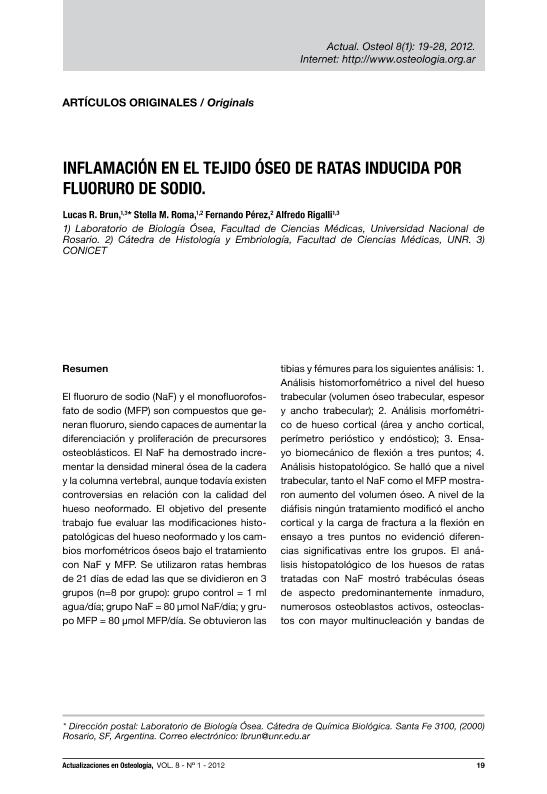Artículo
El fluoruro de sodio (NaF) y el monofluorofosfato de sodio (MFP) son compuestos que generan fluoruro, siendo capaces de aumentar la diferenciación y proliferación de precursores osteoblásticos. El NaF ha demostrado incrementar la densidad mineral ósea de la cadera y la columna vertebral, aunque todavía existen controversias en relación con la calidad del hueso neoformado. El objetivo del presente trabajo fue evaluar las modificaciones histopatológicas del hueso neoformado y los cambios morfométricos óseos bajo el tratamiento con NaF y MFP. Se utilizaron ratas hembras de 21 días de edad las que se dividieron en 3 grupos (n=8 por grupo): grupo control = 1 ml agua/día; grupo NaF = 80 µmol NaF/día; y grupo MFP = 80 µmol MFP/día. Se obtuvieron las tibias y fémures para los siguientes análisis: 1. Análisis histomorfométrico a nivel del hueso trabecular (volumen óseo trabecular, espesor y ancho trabecular); 2. Análisis morfométrico de hueso cortical (área y ancho cortical, perímetro perióstico y endóstico); 3. Ensayo biomecánico de flexión a tres puntos; 4. Análisis histopatológico. Se halló que a nivel trabecular, tanto el NaF como el MFP mostraron aumento del volumen óseo. A nivel de la diáfisis ningún tratamiento modificó el ancho cortical y la carga de fractura a la flexión en ensayo a tres puntos no evidenció diferencias significativas entre los grupos. El análisis histopatológico de los huesos de ratas tratadas con NaF mostró trabéculas óseas de aspecto predominantemente inmaduro, numerosos osteoblastos activos, osteoclastos con mayor multinucleación y bandas de fibrosis peritrabecular. Los animales tratados con MFP, por su parte, mostraron hueso en formación, de aspecto maduro, con un patrón más organizado. La falta de inflamación fue una característica distintiva respecto de huesos de ratas tratadas con NaF. La presencia de inflamación aguda en hueso de ratas tratadas con NaF podría explicar la falta de éxito en el tratamiento con esta droga. Sodium fluoride (NaF) and sodium monofluorophosphate (MFP) are compounds that generate fluoride, being able to increase differentiation and proliferation of osteoblast. It has been demonstrated that NaF increases bone mineral density at the level of hip and spine, although there are still controversies regarding the quality of bone. The aim of this study was to evaluate the histopathological characteristics of bone tissue and bone morphometric differences under treatment with NaF and MFP. Experiments were carried out in female rats which were divided in 3 groups (n= 8 per group): control group = water 1 ml/day; NaF group = NaF 80 mmol/ day, and MFP group = MFP 80 mmol/day. After that, the tibia and femur were obtained for the following analysis: 1. Histomorphometric analysis of trabecular bone (trabecular bone volume, trabecular thickness and trabecular width) 2. Morphometric analysis of cortical bone (cortical area, cortical width, periosteal and endosteal perimeter); 3. Biomechanical three-point bending test; 4. Histopathological analysis. NaF and MFP showed increased trabecular bone volume. At midshaft level the treatment did not modify the cortical width and the fracture load in a three-point bending test showed no significant differences between groups. Histopathological analysis of the bones of rats treated with NaF showed an immature bone net, numerous active osteoblasts, osteoclasts with greater multinucleation and fibrosis peritrabecular. The animals treated with MFP showed bone with mature appearance and a more organized pattern. The lack of inflammation was a distinctive feature compared with bones of rats treated with NaF. The presence of acute inflammation in bone of rats treated with NaF could explain the lack of therapeutic success with this drug.
Inflamación en el tejido óseo de ratas inducidas por fluoruro de sodio
Título:
Inflammation in rat bone induced by sodium fluoride
Fecha de publicación:
06/2012
Editorial:
Asociación Argentina de Osteología y Metabolismo Mineral
Revista:
Actualizaciones en Osteología
ISSN:
1669-8975
Idioma:
Español
Tipo de recurso:
Artículo publicado
Clasificación temática:
Resumen
Palabras clave:
INFLAMACIÓN
,
FLUORURO
,
RATAS
Archivos asociados
Licencia
Identificadores
Colecciones
Articulos(CCT - ROSARIO)
Articulos de CTRO.CIENTIFICO TECNOL.CONICET - ROSARIO
Articulos de CTRO.CIENTIFICO TECNOL.CONICET - ROSARIO
Citación
Brun, Lucas Ricardo Martín; Roma, Stella Maris; Pérez, Fernando; Rigalli, Alfredo; Inflamación en el tejido óseo de ratas inducidas por fluoruro de sodio; Asociación Argentina de Osteología y Metabolismo Mineral; Actualizaciones en Osteología; 8; 1; 6-2012; 19-28
Compartir




